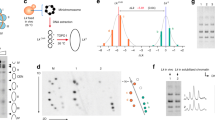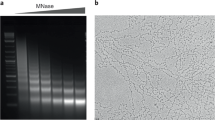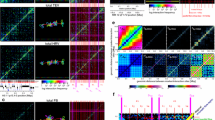Abstract
The packing of mammalian DNA into chromatin plays an important role in cell differentiation and selection of epigenetically marked genes for expression or silencing. The first level of folding, the nucleosome, is evolutionary conserved. It allows transcription, after remodeling and/or histone modifications. The second level, the transcriptionally dormant 30 nm fibre, exhibits species and tissue variations in the chromatin repeat length. Nevertheless, very similar structures of fibres have been observed in all metazoans, and therefore, have to accommodate variable linker lengths with a corresponding change of tilt of the nucleosomes, which is defined by the DNA helical periodicity. So far, none of the models for a regular fibre structure has considered this requirement nor the relationship between repeat length and orientations of nucleosomes in the fibre. Here, we present two regular structural arrangements with negatively tilted consecutive nucleosomes which can compensate for a non-integer number of bp/turn of DNA; one can accommodate a series of structures with discrete repeat lengths differing by 5 bp in the region around 200 bp and the other from around 220 to 250 bp, accommodating repeat lengths differing by 10 to 12 bp.




Similar content being viewed by others
References
Bates AD, Maxwell A (1989) DNA gyrase can supercoil DNA circles as small as 174 base pairs. EMBO J 8:1861–1866
Beard DA, Schlick T (2001) Computational modeling predicts the structure and dynamics of chromatin fiber. Structure (Camb) 9:105–114
Bednar J, Horowitz RA, Dubochet J, Woodcock CL (1995) Chromatin conformation and salt-induced compaction: three-dimensional structural information from cryoelectron microscopy. J Cell Biol 131:1365–1376
Bednar J, Horowitz RH, Grigoryev SA, Carruthers LM, Hansen JC, Koster AJ, Woodcock CL (1998) Nucleosomes, linker DNA, and linker histone form a unique structural motif that directs the higher-order folding and compaction of chromatin. Proc Natl Acad Sci USA 95:14173–14178
Ben-Haim E, Lesne A, Victor JM (2001) Chromatin: a tunable spring at work inside chromosomes. Phys Rev E Stat Nonlin Soft Matter Phys 64:051921
Bordas J, Perez-Grau L, Koch MH, Vega MC, Nave C (1986a) The superstructure of chromatin and its condensation mechanism. I. Synchrotron radiation X-ray scattering results. Eur Biophys J 13:157–173
Bordas J, Perez-Grau L, Koch MH, Vega MC, Nave C (1986b) The superstructure of chromatin and its condensation mechanism. II. Theoretical analysis of the X-ray scattering patterns and model calculations. Eur Biophys J 13:175–185
Burgoyne LA, Skinner JD (1981) Chromatin superstructure: the next level of structure above the nucleosome has an alternating character. A two-nucleosome based series is generated by probes armed with DNAase-I acting on isolated nuclei. Biochem Biophys Res Commun 99:893–899
Butler PJ, Thomas JO (1980) Changes in chromatin folding in solution. J Mol Biol 140:505–529
Daban JR, Bermudez A (1998) Interdigitated solenoid model for compact chromatin fibers. Biochemistry 37:4299–4304
Davey CA, Sargent DF, Luger K, Maeder AW, Richmond TJ (2002) Solvent mediated interactions in the structure of the nucleosome core particle at 1.9 Å resolution. J Mol Biol 319:1097–1113
Dorigo B, Schalch T, Kulangara A, Duda S, Schroeder RR, Richmond TJ (2004) Nucleosome arrays reveal the two-start organization of the chromatin fiber. Science 306:1571–1573
Finch JT, Klug A (1976) Solenoidal model for superstructure in chromatin. Proc Natl Acad Sci USA 73:1897–1901
Gerchman SE, Ramakrishnan V (1987) Chromatin higher-order structure studied by neutron scattering and scanning transmission electron microscopy. Proc Natl Acad Sci USA 84:7802–7806
Greulich KO, Wachtel E, Ausio J, Seger D, Eisenberg H (1987) Transition of chromatin from the “10 nm” lower order structure, to the “30 nm” higher order structure as followed by small angle X-ray scattering. J Mol Biol 193:709–721
Hamiche A, Schultz P, Ramakrishnan V, Oudet P, Prunell A (1996) Linker histone-dependent DNA structure in linear mononucleosomes. J Mol Biol 257:30–42
Harp JM, Hanson BL, Timm DE, Bunick GJ (2000) Asymmetries in the nucleosome core particle at 2.5 Å resolution. Acta Crystallogr D Biol Crystallogr 56 Pt 12:1513–1534
Horz W, Miller F, Klobeck G, Zachau HG (1980) Deoxyribonuclease II as a probe for chromatin structure. II. Mode of cleavage. J Mol Biol 144:329–351
Horz W, Zachau GH (1980) Deoxyribonuclease II as a probe for chromatin structure. I. Location of cleavage sites. J Mol Biol 144:305–327
Koch MH, Sayers Z, Michon AM, Marquet R, Houssier C, Willfuhr J (1988) The superstructure of chromatin and its condensation mechanism. V. Effect of linker length, condensation by multivalent cations, solubility and electric dichroism properties. Eur Biophys J 16:177–185
Lasters I, Staynov DZ (1983) Regular nonsequential arrangements of freely joined chains. Int J Biol Macromol 5:310–311
Leforestier A, Livolant F (1997) Liquid crystalline ordering of nucleosome core particles under macromolecular crowding conditions: evidence for a discotic columnar hexagonal phase. Biophys J 73:1771–1776
Lohr D, van Holde KE (1979) Organization of spacer DNA in chromatin. Proc Natl Acad Sci USA 76:6326–6330
Luger K, Hansen JC (2005) Nucleosome and chromatin fiber dynamics. Curr Opin Struct Biol 15:188–196
Luger K, Mader AW, Richmond RK, Sargent DF, Richmond TJ (1997) Crystal structure of the nucleosome core particle at 2.8 Å resolution. Nature 389:251–260
McGhee JD, Rau DC, Charney E, Felsenfeld G (1980) Orientation of the nucleosome within the higher order structure of chromatin. Cell 22:87–96
McGhee JD, Nickol JM, Felsenfeld G, Rau DC (1983) Higher order structure of chromatin: orientation of nucleosomes within the 30 nm chromatin solenoid is independent of species and spacer length. Cell 33:831–841
Mozziconacci J, Victor JM (2003) Nucleosome gaping supports a functional structure for the 30nm chromatin fiber. J Struct Biol 143:72–76
Pehrson JR (1995) Probing the conformation of nucleosome linker DNA in situ with pyrimidine dimer formation. J Biol Chem 270:22440–22444
Ramakrishnan V (1997) Histone H1 and chromatin higher-order structure. Crit Rev Eukaryot Gene Expr 7:215–230
Rattner JB, Hamkalo BA (1979) Nucleosome packing in interphase chromatin. J Cell Biol 81:453–457
Robinson PJ, Fairall L, Huynh VA, Rhodes D (2006) EM measurements define the dimensions of the “30-nm” chromatin fiber: evidence for a compact, interdigitated structure. Proc Natl Acad Sci USA 103:6506–6511
Schalch T, Duda S, Sargent DF, Richmond TJ (2005) X-ray structure of a tetranucleosome and its implications for the chromatin fibre. Nature 436:138–141
Shore D, Baldwin RL (1983) Energetics of DNA twisting. I. Relation between twist and cyclization probability. J Mol Biol 170:957–981
Staynov DZ, Dunn S, Baldwin JP, Crane-Robinson C (1983) Nuclease digestion patterns as a criterion for nucleosome orientation in the higher order structure of chromatin. FEBS Lett 157:311–315
Staynov DZ (1983) Possible nucleosome arrangements in the higher-order structure of chromatin. Int J Biol Macromol 5:3–9
Staynov DZ (2000) DNase I digestion reveals alternating asymmetrical protection of the nucleosome by the higher order chromatin structure. Nucleic Acids Res 28:3092–3099
Staynov DZ, Proykova YG (1998) Quantitative analysis of DNase I digestion patterns of oligo- and polynucleosomes. J Mol Biol 279:59–71
Suau P, Bradbury EM, Baldwin JP (1979) Higher-order structures of chromatin in solution. Eur J Biochem 97:593–602
Thoma F, Koller T, Klug A (1979) Involvement of histone H1 in the organization of the nucleosome and of the salt-dependent superstructures of chromatin. J Cell Biol 83:403–427
Thomas JO, Butler PJ (1980) Size-dependence of a stable higher-order structure of chromatin. J Mol Biol 144:89–93
Tse C. Hansen JC (1997) Hybrid trypsinized nucleosomal arrays: identification of multiple functional roles of the H2A/H2B and H3/H4 N-termini in chromatin fiber compaction. Biochemistry 36:11381–11388
van Holde KE (1988) Chromatin. Springer-Verlag, New York
Wallrath Ll, Elgin SC (1995) Position effect variegation in Drosophila is associated with an altered chromatin structure. Genes Dev 9:1263–1277
Widom J (1992) A relationship between the helical twist of DNA and the ordered positioning of nucleosomes in all eukaryotic cells. Proc Natl Acad Sci USA 89:1095–1099
Widom J, Finch JT, Thomas JO (1985) Higher-order structure of long repeat chromatin. EMBO J 4:3189–3194
Williams SP, Athey BD, Muglia LJ, Schappe RS, Gough AH, Langmore JP (1986) Chromatin fibers are left-handed double helices with diameter and mass per unit length that depend on linker length. Biophys J 49:233–248
Wolffe AP (1998) Chromatin: structure and function. Academic Press, San Diego, London
Woodcock CI, Grigoryev SA, Horowitz RA, Whitaker N (1993) A chromatin folding model that incorporates linker variability generates fibers resembling the native structures. Proc Natl Acad Sci USA 90:9021–9025
Woodcock CI, Frado LI, Rattner JB (1984) The higher-order structure of chromatin: evidence for a helical ribbon arrangement. J Cell Biol 99:42–52
Worcel A, Benyajati (1977) Higher order coiling of DNA in chromatin. Cell 12:83–100
Worcel A, Strogatz S, Riley D (1981) Structure of chromatin and the linking number of DNA. Proc Natl Acad Sci USA 78:1461–1465
Acknowledgements
We are grateful to D. Rhodes and V. Ramakrishnan for helpful discussions and suggestions and to M. Sanderson for critical reading of the manuscript. Support from the Wellcome Trust is gratefully acknowledged.
Author information
Authors and Affiliations
Corresponding author
Additional information
Communicated by E.A. Nigg
Electronic supplementary material
Below is the link to the electronic supplementary material.
ESM 1
(DOC 57.5 kb)
Rights and permissions
About this article
Cite this article
Staynov, D.Z., Proykova, Y.G. Topological constraints on the possible structures of the 30 nm chromatin fibre. Chromosoma 117, 67–76 (2008). https://doi.org/10.1007/s00412-007-0127-3
Received:
Revised:
Accepted:
Published:
Issue Date:
DOI: https://doi.org/10.1007/s00412-007-0127-3




